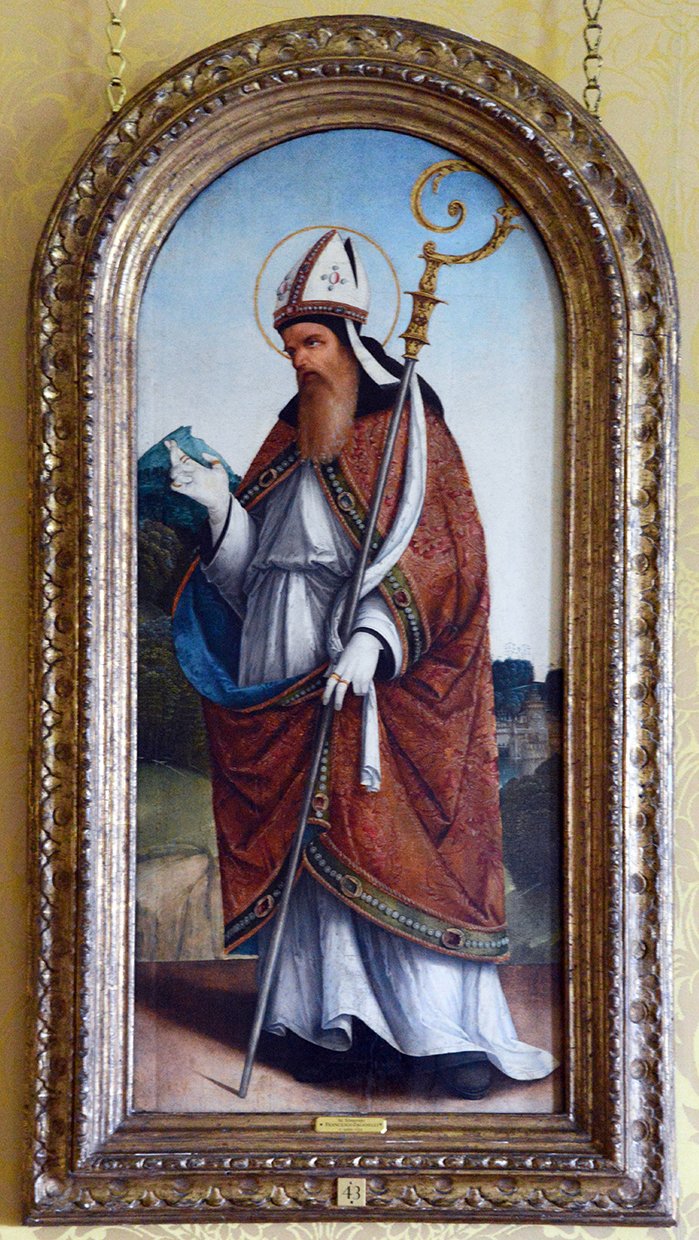
St Simeon, Full Length
c.1499-1532 (FRANCESCO); c.1499-1509 (BERNARDINO)
Oil on panel, with an arched top. 36 1/2 ins by 16 ins
Collection Details
With Salocchi & Freschi, Florence, 1962; with Horace Buttery and Agnew’s, from whom acquired by Lord Faringdon, 1965.
Literature
R Roli, ‘Sul problema di Francesco & Bernardino Zaganelli’, Arte Antica e Moderna, 31–2, 1965, p.231 and pl.81b (as by Bernardino); Raffaella Zama, Zaganelli e dintorni, 1989, p.9 (as ‘attribuito a Bernardino’); Raffaella Zama, Gli Zaganelli, Rimini, 1994, no.36.
Background
Attributed to Francesco Zaganelli and called St Simeon in earlier editions of this catalogue, this panel now appears more problematic. First, it cannot represent St. Simeon, since he was not, and is never portrayed as, a bishop. There are in fact no attributes by which to identify this bishop saint.
Second, more recent scholarship has tended to attribute this painting to Bernardino rather than Francesco – but this has gone with a new tendency to see the probably younger and shorter-lived Bernardino as the more creative brother in the partnership. The brothers were very eclectic, making determination of their joint and separate styles difficult, and it was anyway only in 1505–6 that they were temporarily working apart and signing works individually. There are similarities in type between this bishop saint and the High Priest in the Marriage of the Virgin in Capodimonte (Roli, op cit, p.231 and fig.82b; attributed by Roli to Bernardino but by Zama to both brothers), and the bishop saints in the Madonna and Child enthroned with the Magdalen and a Bishop Saint of unknown location (Berenson, Central and North Italian Schools, 1968, p.454, pl.1035; attributed to Bernardino alone), and the Madonna and Child enthroned with SS Christopher and Apollinaris in the Santuario di Castel di Mezzo (Berenson, p.452, pl.1048; plausibly assumed by Roli and Zama to have been executed by Francesco alone when he was working in the Marches).
Although the Forlivese echoes in the present panel might seem to point to Francesco as its author, the absence of bizarreness, and the sensitive treatment of light and landscape, are actually closer to Bernardino in the one work that he signed on his own, the St. Sebastian in the National Gallery (Berenson, p.452, pl.1034), the central panel of the polyptych painted for the Carmine in Pavia in 1506. Yet it must also be admitted that there are certain affinities with the work of the Zaganellis’ follower, Girolamo Marchesi, notably with his Madonna and Saints in San Marino (exh cat Mostra di Melozzo, e del Quattrocento romagnolo, Forlì, 1938, No.149). Zama (1994), nevertheless, considers that the picture is by Bernardino Zaganelli, but regards its companion, the Saint Helena at Tempe (Arizona, Arizona State University, University Art Collection) as by a collaborator.
The Trustees of the Faringdon Collection 25.
All rights reserved.
